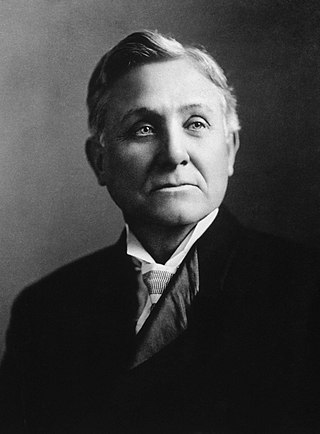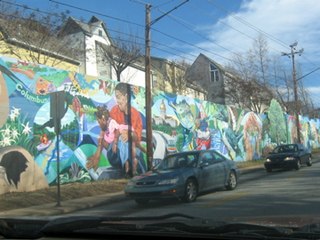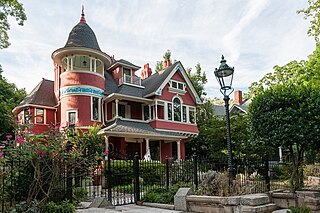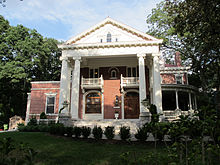
Victorian architecture is a series of architectural revival styles in the mid-to-late 19th century. Victorian refers to the reign of Queen Victoria (1837–1901), called the Victorian era, during which period the styles known as Victorian were used in construction. However, many elements of what is typically termed "Victorian" architecture did not become popular until later in Victoria's reign, roughly from 1850 and later. The styles often included interpretations and eclectic revivals of historic styles (see Historicism). The name represents the British and French custom of naming architectural styles for a reigning monarch. Within this naming and classification scheme, it followed Georgian architecture and later Regency architecture, and was succeeded by Edwardian architecture.

Asa Griggs Candler Sr. was an American business tycoon and politician who in 1888 purchased the Coca-Cola recipe for $238.98 from chemist John Stith Pemberton in Atlanta, Georgia. Candler founded The Coca-Cola Company in 1892 and developed it as a major company.

Little Five Points is a district on the east side of Atlanta, Georgia, United States, 2+1⁄2 miles (4.0 km) east of downtown. It was established in the early 20th century as the commercial district for the adjacent Inman Park and Candler Park neighborhoods, and has since become famous for the alternative culture it brings to Atlanta. It has been described as Atlanta's version of Haight-Ashbury, a melting pot of sub-cultures, and the bohemian center of the Southern United States.

Inman Park is an intown neighborhood on the east side of Atlanta, Georgia, and its first planned suburb. It was named for Samuel M. Inman.

Lake Claire is a neighborhood on the east side of Atlanta, Georgia, United States, comprising approximately 1,200 homes. It is situated entirely in the DeKalb County side of the city, east of Candler Park, north of Kirkwood, west of Decatur, and south of Druid Hills.

Poncey–Highland is an intown neighborhood on the east side of Atlanta, Georgia, located south of Virginia–Highland. It is so named because it is near the intersection of east/west Ponce de Leon Avenue and north/southwest North Highland Avenue. This Atlanta neighborhood was established between 1905 and 1930, and is bordered by Druid Hills and Candler Park across Moreland Avenue to the east, the Old Fourth Ward across the BeltLine Eastside Trail to the west, Inman Park across the eastern branch of Freedom Parkway to the south, and Virginia Highland to the north across Ponce de Leon Avenue. The Little Five Points area sits on the border of Poncey–Highland, Inman Park, and Candler Park.

The Governor's Mansion is the official home of the governor of the U.S. state of Georgia. The mansion is located at 391 West Paces Ferry Road NW, in the Tuxedo Park neighborhood of the affluent Buckhead district of Atlanta.

Druid Hills Historic District is a historic district in Druid Hills and Atlanta in DeKalb County, Georgia, United States, that is listed on the National Register of Historic Places (NRHP).

The architecture of metropolitan Detroit continues to attract the attention of architects and preservationists alike. With one of the world's recognizable skylines, Detroit's waterfront panorama shows a variety of architectural styles. The post-modern neogothic spires of One Detroit Center refer to designs of the city's historic Art Deco skyscrapers. Together with the Renaissance Center, they form the city's distinctive skyline.

The Edward Inman "Swan" House is a mansion in Atlanta, Georgia. It was designed by Philip T. Shutze and built in 1928 for Edward and Emily Inman. The house is currently part of the Atlanta History Center, and it has been featured in The Hunger Games: Catching Fire and The Hunger Games: Mockingjay, Part 2.

The Edward C. Peters House, also known as Ivy Hall, is a Queen Anne style house in Atlanta, Georgia. It occupies a lot covering an entire city block on the southeast corner of Piedmont Avenue and Ponce de Leon Avenue in Midtown Atlanta, just north of the SoNo neighborhood. Its current owner is the Savannah College of Art and Design.

Briarcliff was the mansion and estate of Asa Griggs "Buddy" Candler Jr. (1880–1953), and is now the Briarcliff Campus of Emory University. The estate was built in 1922 on 42 acres on Williams Mill Road, now Briarcliff Road in Druid Hills near Atlanta. Williams Mill Road would be renamed Briarcliff Road in the 1920s after the estate that Asa Jr. would build there. It was listed on the National Register of Historic Places in 1988.

The Rufus M. Rose House is a late Victorian, Queen Anne style house located in the SoNo district of Atlanta, Georgia. Occupying a narrow lot on Peachtree Street, one and half blocks south of North Avenue, the house was built in 1901 for Dr. Rufus Mathewson Rose. The architect was Emil Charles Seiz (1873-1940), who designed many residential and commercial structures in the city, including the 1924 Massellton Apartments on Ponce de Leon Avenue.

Asa Griggs "Buddie" Candler Jr. was the eccentric son of Asa Griggs Candler Sr., co-founder of Coca-Cola. Candler Jr. helped build his father's business into an empire. He later became a real-estate developer, opening the Briarcliff Hotel at the corner of Ponce de Leon Avenue and N. Highland Ave. in Virginia Highland, Atlanta, Georgia, United States.

Callanwolde Fine Arts Center is a 501(c)(3) non-profit community arts center that offers classes and workshops for all ages in visual, literary and performing arts. Special performances, gallery exhibits, outreach programs and fundraising galas are presented throughout the year. Callanwolde is also involved in community outreach, specializing in senior wellness, special needs, veterans, and low income families.

Candler Mansion may refer to:

The Beath–Dickey House (1890) is a Queen Anne Victorian house located at 866 Euclid Avenue in the Inman Park neighborhood of Atlanta, Georgia. It was one of the houses of note when the Inman Park – Atlanta's first streetcar suburb – was established.
Lullwater House is the president's mansion at Emory University near Atlanta, Georgia, overlooking Candler Lake. It was built in 1926 as the residence of Walter T. Candler, son of Coca-Cola founder Asa Griggs Candler. The mansion is in the form of an L, in Tudor-Gothic revival style. The architects were Ivey and Crook.

Lucy Beall Candler Owens Heinz Leide was an American heiress. She was the only daughter of Asa Griggs Candler, the co-founder of The Coca-Cola Company.

Fire Station No. 6 is a historic fire station in Atlanta, Georgia, United States. Built in 1894 with designs by Bruce & Morgan, the building is the oldest freestanding fire station in the city. Located in the Sweet Auburn neighborhood, the building is a contributing property in the Martin Luther King Jr. National Historical Park.




















